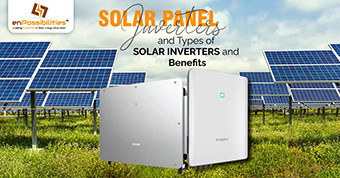Solar power does not generate electricity in a form that could be used to power an appliance like the lamp on your table. Solar Inverters from enPossibilities transform the energy that is caused by your solar panels into a form that can be utilized in many ways.
Consider it a means of exchanging your power for other forms of currency. Even if you have a fistful of Yen in your possession, you won’t be able to pay for lunch in the United States until you stop and convert it into USD.
Your house is wired to carry alternating current (AC), which is a type of electric current. Direct current is the original form of the power that is produced by solar panels (DC). Solar Inverters in India take the raw DC electricity and convert it into clean, usable AC power that your lamp can use to illuminate the room.
EnPossibilities Inverters are among the most essential components of the equipment that make up a rooftop solar system. You can choose between string inverters, microinverters, or power optimizers as your solution.
Types of Solar Panel Inverters
String Inverters
In string inverters, there is one centralized inverter, or, to continue with the metaphor, there is one central location where currency is exchanged.
This is a standard inverter, and it will function appropriately for your needs provided that you do not have any overbearing shade from adjacent trees or an oversized chimney. It is also to your advantage to arrange your solar panels so that they all face in the same direction.
The industry has standardized on string solar inverter price in India for home because of their low cost and widespread availability.
Pros:
- Standard inverter
- It works nicely even when there is no shade.
- Low cost
Microinverters
Microinverters are small components that transform power and are incorporated inside each individual solar panel. Consider it the equivalent of having a little currency exchange station located on each of the nearby street corners.
Because of this, each panel is able to function to its full potential while remaining autonomous from the discussions around it. Even if the board next to it is covered by a tree limb for the better part of the day, none of the other panels will be able to prevent it from converting at its maximum capacity. Only one of the panels will be affected by any decrease in efficiency.
You are also able to check the functioning of each individual panel with the use of microinverters. This is helpful in identifying any problems with a single board so that you can have it repaired before it slows down the productivity of the entire system.
This type of inverter is likely to cost more than string inverters, but it has the potential to save you money in the long run by allowing you to extract more power from your system as a whole.
Additionally, if you wish to use more power, it is simple to do so with the help of microinverters. Suppose you decide to purchase an electric vehicle; in order to charge it overnight, you will require a higher level of electrical capacity. Adding more solar panels and inverters to a string inverter system is a more straightforward and more cost-effective option than adding an additional central inverter to the system.
Pros:
- The power output of an entire solar panel system will not be affected by the presence of a nearby tree.
- Individual panel monitoring available
- The installation of a second central inverter is more complex and costly than increasing the amount of electricity that is required.
- Excellent for rooftops with solar panels that can be oriented in a variety of directions
Power Optimizers
Both in terms of their functionality and their cost, power optimizers fall somewhere in the middle of the spectrum between string inverters and micro-inverters.
Power optimizers, much like micro-inverters, consist of a component (the “optimizer”) that is positioned beneath and embedded within each solar panel. However, these inverters optimize the current before delivering it to a single central inverter so that the DC can be converted to AC elsewhere.
This is more cost-efficient than a standard micro-inverter setup, but it is more efficient than a string inverter because any slow production from one panel does not slow down the entire system.
Picture yourself being able to jump to the front of the line at the bureau de change. It is not relatively as quick or convenient as having your own exchange office a few feet from your home, but once you arrive to the central office, there is no waiting around.
As the technology improves, micro-inverters and power optimizers are becoming increasingly popular, and their prices are falling as a result.
Pros:
- superior to string inverters in terms of efficiency
- a more cost-effective option than micro-inverters
- Individual panel monitoring available
enPossibilities is the one-stop destination when it comes to getting your hands on the best solar panel inverters at affordable prices.

